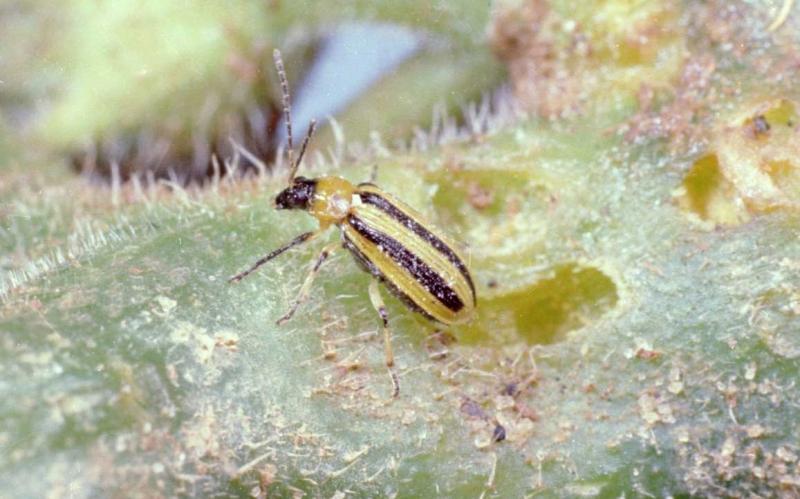Written by Rhoda Burrows, former Professor & SDSU Extension Horticulture Specialist.
Description

General Description: Some varieties form long vines that may ramble or be trellised; others are bush types that fit more easily into a small garden or even a large container.
Types: Long green slicing, burpless slicing, round lemon, Armenian, mini snack-sized, and pickling (Figure 1). Using slicing types for pickling may result in mushy pickles. Most pickling cucumbers can be used for fresh eating, especially when young. Some types are more bitter than others, especially under drought or heat stress.
Fun Fact: Cucumbers were believed to have originated in India and spread through Greece and Italy. They came to North America in the mid-1500s.
Planting

Timeline: Sow seeds after chance of frost has passed and soil temperature has warmed to 70°F (Figure 2). Days to harvest range from 50 to 70 days.
Sowing: Direct seeding is the easiest method for starting cucumbers and generally results in deeper roots. Cucumbers may be planted in rows, or in hills.
Rows: Sow seeds ½-inch deep. Space seeds about 6 inches apart. Allow 2 to 3 feet between rows for the vines to spread. Thin to 10 to 15-inches apart after the seedlings emerge.
Hills: Flat mounds of soil 4 to 6-inches high and one to two-feet in diameter and 3- to 5-ft. apart, are planted with 4 to 6 seeds, thinned down to 2 or 3 plants after emergence.
Transplants: If seeds are started indoors, transplant when the plants have no more than two true leaves, as larger plants suffer too much transplant shock, eliminating any benefit over direct-seeding.

Pollination Issues: Most cucumber plants bear separate male and female flowers on the same plant (Figure 3). Bees pollinate cucumbers; a flower must be pollinated within 4 hours of opening. Poor pollination can result in a fruit that Is not filled out on one end. A few varieties bear only female flowers, and require “pollinator” plants with male flowers to set fruit.
The female blossoms can be identified by the presence of a miniature fruit at the base of the blossom. Depending on weather, male blossoms may appear for a week or more before the female.
Plant Care
Trellising: Using trellises, stakes or cages to support vining types can result in cleaner, straighter fruit.
Watering: Cucumbers need at least one inch of water from rainfall or irrigation each week during the growing season. Always soak the soil thoroughly when watering. To decrease diseases, use drip irrigation, a soaker hose, or when possible water when the leaves will dry quickly afterward.
Weeding and Mulching: To control weeds, use mulch or cultivate very shallowly. Cucumbers respond to mulching with soil-warming plastic in early spring or organic materials in the summer.
Fertilizing: When the plants begin to blossom, fertilize with nitrogen (a lawn fertilizer will work well as long as it is not a “Weed and Feed” type with herbicide included), about 1 tsp per plant, or apply a fish emulsion solution according to package directions.
Pest and Diseases

Major Pests
- Cucumber Beetles (Striped or Spotted ): Cucumber beetles damage plants by eating leaves as well as stems and fruit (Figure 4). The most damage is on young plants, but the beetles can also carry bacterial wilt. Varieties with a more bitter tendency are more attractive to cucumber beetles. See What's Bugging Your Garden? Cucumber Beetles for more information on managing cucumber beetles.
Major Diseases
- Bacterial Wilt: Plants are infected with the bacterial wilt disease by the attack of cucumber beetles. The disease organism overwinters inside the beetles' bodies. Plants usually are infected with the disease-causing bacteria long before they show any symptoms. When the vines wilt and collapse (usually about the same time that the first cucumbers are half grown), it is too late to prevent the disease, and the plant should be removed.
- Powdery Mildew: Most newer varieties are resistant to powdery mildew, but it may decrease yield on non-resistant varieties by forming a white powdery infection on the leaves.
- Other Diseases: There are a number of other leaf spotting or fruit rotting diseases; contact SDSU Extension if you need help managing cucumber diseases.
Harvest
Pick cucumbers when they reach the desired size and before the seeds toughen. If very large cucumbers are left on the vine, plant yield will decline. See Harvesting Cucumbers for more information on proper harvest stage.
Do not pick when vines are wet, because of the danger of spreading diseases. The cucumber fruit grows rapidly to harvest size and should be picked at least every other day.
Storage and Preparation
Storage: Store for up to a week in the refrigerator in loose or perforated plastic bags. The ideal storage temperature is 55°F, so a cool basement floor could also be used. After a few days at refrigerator temperatures, the fruit may develop sunken spots that are caused by cold damage.
Cooking Tips: For preparation and pickling details see our Pick it! Try it! Like it! resource for cucumbers.
Nutrition Facts: Fat free, sodium free, cholesterol free, low calorie, and good source of vitamin C


